

FAKIR: It actually started at a very young age. I remember as far back as four or five years old being a little bit different than other people. I wasn't too aware of it then, not until I got a little older and got into school. At that stage a lot of strange phenomena occurred in my life. I would go into trance states very easily and I learned at a very early age to just automatically go into lucid daydreams and could live a life quite separate from the one I was living in my physical body, and then come back and do things I got from the lucid daydreams in my body.
I guess the crucial point for me was when I reached puberty. I lost a lot of my abilities. I had an ability of psychometry... I would ride my bicycle out into the country, and where I lived was an Indian reservation. I'd find an Indian campground or an Indian burial place, pick up a rock, sit there for hours holding the rock and read the whole history of what happened in and around the rock. Including the life of the man or woman who was buried underneath it. Things like that... I also had the ability to do some psychokinetic things like when I was in a lucid daydream I could look at small objects like a piece of paper or toothpick and make it move.
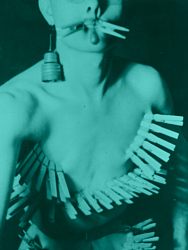 Clothes Pin Fans, 1944 (Age 14). Fakir's early bodymod experiments involved temporary piercing of septum and lobes, plus elaborate body fans made of his mother's spring-type clothes pins. |
FAKIR: Well, it didn't happen to them, but it did happen to me. I didn't ask for it to happen for it, it just was there. In my early years I was very afraid of these things. It made me different from other people and I tried to hide it as much as I could and tried to not have people see this. I thought I was going crazy or something like that. I was very concerned that I was not like a lot of other people.
BME: Were you actually concerned that you might be imagining the whole thing?
FAKIR: No. That was the frightful part of it. What I did was not imaginary, it was very real, and so my whole introduction to life was a bit different. My relationship to spirit and body was very different, apparently, to other people.
Where I grew up I was impressed heavily with the programming of my parents, who were not Native Americans, and I was impressed heavily with the Lutheran church. I had to sit in a choir loft. I liked the ritual, but a lot of what happened there didn't ring true to me.
Like I said before, when I reached puberty I lost a lot of my abilities. The lucid daydreaming went on, and I discovered the erotic component in all of this. I also started to look in libraries -- I lived in libraries -- I was a bookworm. I was very curious to find out how other people lived because everything was very limited and restricted.
BME: By other people you mean other cultures?
FAKIR: Yes, even in our own culture. Places away from this small remote town in Aberdeen, South Dakota. I was highly inspired particularly by National Geographic because we had a school library that had all of these bound up. I would spend hours reading them. I also read encyclopedias. I would started with one particular set and read all of volume A, then all of volume B, and so forth and go through the whole set, and then take another set and read it. Which most kids did not do in the seventh grade.
BME: When did you actually start exploring rituals of the body?
FAKIR: I started doing that even before puberty. I was very caught up in the idea of ordeals, initiations, and body rituals. I had been exposed to it somewhat as a child because of the Native Americans around me, and their tales.
BME: Is that in person, or through psychometry?
FAKIR: No, this was firsthand. This was in the 1930s and at that point there was a policy of assimilation of Indians by the American government. So they would take the Indian children and board them or have them stay with other Indian families in this small town and they would make them go to school with us in hopes that they would stop being Indians and become something else.
My first overt moves were quite secret. I realized I was different, and at about age twelve I was confirmed in the Lutheran church and I was a bright little boy and I had all the answers. We had a very gentle Lutheran pastor and he was very fond of me. He would say, "Roland, tell me about the doctrine of trance-substantiation," and I would give it to him in full. But I never believed anything they told me, because it didn't ring true with what my insides told me. So I rejected soundly all of those notions from a very early age, and put up a good front. I found you could get by better in this world if you didn't flaunt your differences, and I practiced everything that I wanted to do, things that made me fulfilled as a human being, in secret for the next thirty years.
BME: Over that time you slowly started to meet people?
FAKIR: No, I didn't meet anyone. There was no one to meet, and no one to share with, for approximately twenty years. After I moved away, even then I had a hard time because my secret life was very fulfilling and a very large part of my waking hours, but again, I had to hide it all, and wait until I could find people who were sympathetic.
BME: Did you feel a need to find others?
FAKIR: I wanted to find others very much but under the circumstances it was not possible. Under the cover of having photography as a hobby I started back in my very early age doing darkroom work. That way I could get some privacy to do what I was going to do. I could go into my mother's fruit cellar, lock the door, and I was always developing film under a red light. Actually I would be in there ripping flesh.
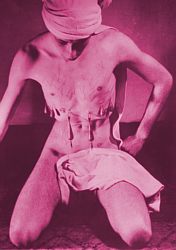 Needling, 1947 (Age 17). A few years later, Fakir did his first self-tattoos on the chest and began a practice of needling and sewing weights to his skin in the style of the sadhus of India he had seen in National Geographics. |
FAKIR: No. I had the advantage of the cover of this photography. It was also a blessing in disguise... I had this desire somehow, not to share, but to document everything I did. Starting at age fourteen or so I started to make photographs periodically of every body thing that I did. All the modifications and body play practices.
BME: Did you ever think then that it would get as public as it is now?
FAKIR: No. All I was trying to do was stay out of insane asylums. I knew if I let people know fully what I was doing they would lock me up because that's what they did in the 1930s if you were that different. For instance, I wanted a permanent body piercing at about thirteen or fourteen, and I did my first piercing when I was fourteen on myself. I knew nothing about piercing but I had to have this hole in my body. It meant a lot to me. I had seen a picture in an old National Geographic of an old south seas island man, who had just had a child; he was a father. So as a father he was entitled to have a hole bored in his nostril. In the picture, the caption was all I had to go by. They used a ring of green coconut shell that was springy, made a sharp point in it, pried the ends apart, put it on his nose, knocked the little prop out that held the ends apart, and the ends bit down into the flesh. The caption said "after some time a hole was formed." That's all I knew about body piercing. No one in this community even had a pierced ear. It was a totally unheard of, unknown phenomena. It would be considered in contempt, in disgust, you were a freak if you had an ear piercing.
So I was sitting in the choir loft of the Lutheran church in my lucid daydreams and I came up with a scheme to do this. Obviously there were no green coconuts in South Dakota, and I couldn't sit in the choir loft with this on while it bit through my flesh. So I found another way to do that. I had played with my body a year or two prior to that with my mother's spring clothespins. I would make clothespin fans. These were handy devices and I thought I could make a piercing with that, like the coconut ring. I took a clothespin, drilled a hole in one side, a little nail in the other, and then I had to figure out where to put this because you couldn't be obvious. The one part of your body that didn't exist, that was never looked at, that was never exposed, were the genitals. Well, I had a dick, and I liked my little dick, and I decided this was the place to put it where nobody else will ever notice it. One day I put the clamp/clothespin on my foreskin and let the spring loose, and ouch, it hurt! I left it on, determined to make a hole like the south seas island man did in the nostril. After some time instead of a very sharp bite it developed into a sort of an ache and that moderated into a lesser strong sensation, and sometime late that night after I was wearing loose baggy pants all day, I had a strange sensation there. I went down to the bathroom and turned on the light and low and behold the little nail had gone through the skin and popped out the hole in the other side. I put in a little copper ring and I still have that piercing today. When I do my Piercing Intensives school I usually tell that story and show them... "Here it is, still there!"
After that I followed suit on everything I could find and whenever I could I would pierce myself, attach the piercings to a cord and pull on it, I got into the habit of doing the Indian custom of hooking hooks with weights on them onto my body and dancing around into a state of ecstasy. I was doing all of this at fourteen or fifteen.
Then I wanted a tattoo at about age seventeen or eighteen. So I got my mother's sewing needles, put them in a little pin- holder, got some India Ink, put a little Listerine in it, and dipped the needles in there and made my first tattoo.
BME: And you've still got that as well.
FAKIR: Yup. And I saw another picture in an encyclopedia of an Ibitoe, a wasp-waisted boy of New Guinea. It said above all things, these people admired a well-spiked nose and a small waist. So I found a belt, and in secret, and at night, I would put this wide belt on and pull it tight. I would become the Ibitoe. From wearing the belt I got sensations and found I could do shifts in consciousness, all of which played into my earlier experiences with lucid daydreaming and trancing.
BME: Did you build back the things you lost at puberty?
FAKIR: Well, it wasn't so much loss as transformation. I moved from stage to stage to stage. In my late teens I had what I'd call my first real transformative experience, and that was against the coal-bin wall. [ You can read about this in Body Play #8]. That had to do with bondage, and sensory deprivation and so-forth. I had this very slow, conscious, cell-by-cell, long-term lifting out of my body and experienced my consciousness away from my body. Almost all of my body experiments and modifications have sooner or later lead to some kind of transformative experience that changed me forever for the rest of my life.
 Ball Dance, 1955 (Age 25). Fakir's practice of bearing weights on body piercings was continued for 40 years. In this 1955 photo, he has 48 half-pound lead weights attached to hooks in his chest and back for a six hour dance. After exposing others to his ecstatic ritual that was previously unknown in Western Culture, he had to give it a name: "The Ball Dance". |
FAKIR: It's pronounced "Fahkeer Mooshuhfar". Since I was an avid reader and I looked for curious stuff, I first ran across it in a Ripley's cartoon. There was a man who lived in 12th century Meshed Persia who called himself Fakir Musafar, and I admired this guy because he had a message but he never seemed to get it across to anyone. He said, "You can learn about God through your body." He had large permanent piercings through his chest, six daggers through deep amounts of tissue, and he had big permanent piercings up and down his arms to which he fastened horseshoes. He went around for eighteen years like this and nobody got the message.
I held that image of this previous pioneer in body modification until the late 1970s. I came out of the closet when I moved to California. I finally started to find some people who were sympathetic. The first one I found that was really helpful was Davy Jones the tattoo artist. I had for years wanted a large tattoo. I had for years done small ones on myself including the bottom of my foot with a magic symbol. To me, tattooing was a magic symbol. It was never pictorial, and you didn't go in and pick the design off the wall. You had to wait until you had a vision and you saw your body with this mark. Then you got the mark and something happened and your whole life changed. That was the way I'd always seen tattooing. I guess I was influenced by all of the reading and all of the other cultures because that's what it's all about in Borneo or Marquesian Islands. It's not done solely for decoration, it's part of an initiation, a rite of passage. It's part of transformation. I did a photograph of my back where this vision kept appearing and I kept drawing little by little by little until I had a design that matched my vision. I rendered it up on a big board with the photo and I went around for years to tattoo artists. This was in the late fifties. I got a very cold reaction everywhere I went. I'd say, "This is what I'd like tattooed on my back," and the old tattoo artist sitting in San Francisco or St. Louis would say, "Well, that's nice sonny, but how about a panther, or Mom or an anchor." I said, "I don't want Mom, I don't want an anchor, I want this!" They simply would not do it.
In the early 1960s I met Davy Jones who was a merchant seaman who jumped ship several times and had somewhat the same inclinations. He had lived in other cultures, in Western Samoa, had gotten the flying fox tattoo all up his hip and down his thigh. He'd done his ritual initiation with a pig's tooth, a hammer, and soot, and grease. When he saw my drawing, he said "I'd love to put that on. I know what you're doing." "Great, what time can we start?" It was a Sunday afternoon, and I'd just gone over to have a consultation with him. He said, "How about right now?" I said "great" so he locked the shop, he called someone over to help stretch the skin, and we put on the larger part of the outline.
Later Davy Jones came when I asked him (if I signed a release that if I died or was found mutilated or injured I would not hold him responsible) a year or two later and we did the Kavadi that I always wanted to do... the framework with the spears, something you can't do to yourself. And then later, my next super-transformative experience was the first time I really hung free (with help) so I could go way out into space by the piercings in my chest.
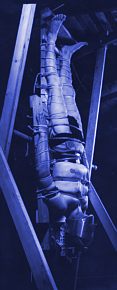 Witches Crade, 1978 (Age 40). One of the most effective ways to create an out-of-body state is use of the Witches Cradle. Fakir is lashed on this one and rotated 360 degrees for several hours to bring him to the "edge" of his body/spirit interface and a wild inner-space trip. |
FAKIR: That gets to the coming out and how I assumed the name... I met a man, an eccentric millionaire called Doug Malloy... Or he met me, he traced me out back there in the late sixties. By this time in the small underground, particularly the SM and fetish community, I was letting it be known what I did and I was showing pictures of myself. Even some that I had taken when I was in my teens. When he saw this he latched onto me and I became a protege of his. Or he was more like a patron -- He supported whatever it was that I wanted to do. He would provide me with the opportunity to do more elaborate things. He was an interesting man who saw visions. He was also the guy of course that sparkplugged the beginning of the body piercing movement and was also a patron for Jim Ward (we were together in those days). Except I had been around for many, many more years before Jim ever got any.
PFIQ had started, and in 1977 they had the first international tattoo convention in Reno, Nevada. Doug was in with the organizers who were from New York and all over and they wanted a grand event. They were going to get three or four hundred people to Reno in the off season when the rates were cheap. They set it up and he said, from a vision of his, "You should go, Roland, and show them everything you can do, because this is a favorable audience and they will understand it." I spent months doing beds of nails, props, the contortions, the yoga, the piercing, the pulling on the piercings. All of these things I had been doing I worked up into a very spectacular act for the Reno convention. Now he says, "You need a name. You can't go in there as Roland! That isn't going to work." So I said, "Alright, I'll take the name of the person I admire most, Fakir Musafar from Meshed Persia, since I have pretty the same message he had. By using your body, modifying your body, you can go into states of consciousness and discover the true nature of life and yourself." So I took the name Fakir and even painted it very fancy. And that's how Fakir got his name.
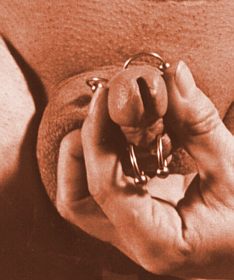 Foreskin Rings, 1965 (Age 35). Fakir did his first permanent piercings in 1944 at age 14. It was a foreskin piercing done in secret with a spring-type cloths pin. This piercing is the one by his left thumb in the photo. Three additional foreskin piercings were made later and he subincised his urethral opening. |
FAKIR: Oh yes. Somebody just the other night said, "well, I'm going to have Fakir come over and participate in our week of ritual." "FAKIR! YOU KNOW FAKIR? Oh my God!" It's like this all over the world.
Now, most of the reputation Fakir has came because in 1983/84 I connected with Andrea Juno and Vale who were struggling along to do a punk paper, and they wanted to do books. I met them and I suggested, "look, this is something a few people at least are really keen on," and I had already coined the word "Modern Primitive" and used it several times in PFIQ, like in 1977. I said to them, "I'll give you all the pictures and all the interviews you want, and all my viewpoints, and you find a couple of other people and you do a book called 'Modern Primitives'" Andrea said, "We'll lose on it, we'll print a thousand copies and nobody will buy it. We'll never sell them." She was convinced this was a dumb subject. So Vale went ahead anyway. They took twenty-seven hours of interview with me, and used out of the huge stack of transcripts only a few very sensational things and left out all the philosophy. They took all of my pictures and used the hottest ones. So in 1985 the book came out and I think since then it's been printed twelve or fourteen times and there are about half a million copies of it wandering around the world. That one more than anything else had my message in it, and it has inspired more people than I can dream of.
I've done extensive educational work. My goal, unlike some of the others, was not to do show-biz, but my goal was to do private experimentation. Small, private rituals, work with people who really understand what I'm doing, document it, and then write about it. If they did things, or were inspired to do things by what I did, I would help them do it. We would document it and I would put that out. That's basically what I have in Body Play.
FAKIR: That's bullshit. I do know Doctor Brown... I went down there and interviewed him, and had Annie Sprinkle interview him. "The famous dick doctor!" I had a long, many year connection with him but he's long since disappeared for me.
The full story of how I did those piercings on myself by slowly forcing through a thin steel rod is in Body Play #14.
BME: Are those intramuscular?
FAKIR: No, they are not. They are ahead of the pectoral muscle and they are through as much breast tissue as you can get. I've seen a few of these done, and it makes me sick because the ones I've seen definitely aren't going to work. And you couldn't hang from them. They're in the wrong place. It's just not right.
BME: I was told that during the healing you got seriously ill and were long-term hospitalized?
FAKIR: Not true. [laughs] I had done the hanging a number of times, including the transformative one with Davy Jones out here in my garage which was empty and like a Mandan lodge with light-shafts coming through the metal. After that one I decided that I would do this periodically, probably once a year. I wanted to do, as the Aricura people did, where this custom originated back in South Dakota... They very often would do this and leave the pegs in for deep piercings and let them heal up, so the next time they did it they didn't pierce it, they just put thongs or something through the piercings.
It was after the fourth or fifth one of these that I decided I was going to make a permanent piercing here. No one had ever done that so I decided I would try that. I did them one at a time, [again, see Body Play #14] I used a clamp, and I screwed them through slowly, it was a heavy duty stainless steel rod.
BME: A 14ga?
FAKIR: About that. It wasn't that large.
BME: Didn't you have problems with abcessing due to inadequate drainage?
FAKIR: No. Again, getting back to the lucid daydreaming and the psychokinetic abilities, I've always had this relationship with my body that few people have. I went through the Kavadi experience with all the iron rods and in my case you can make huge wounds. If it's done under trance, if it's done shamanically, there is no trace of a wound, there is no bleeding, and there is no healing problem. I teach this to people and they do it partly in the body piercing that I teach here at the school.
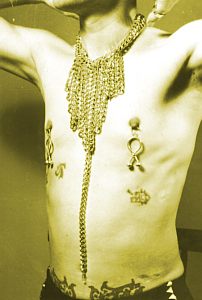 Nipple Hooks, 1957 (Age 27). Fakir didn't know anyone with pierced nipples in 1956, but had a passion for this erotic bodymod. He pierced his own nipples with a sewing needle and left four strands of silk thread in the piercings to heal. In this photo a year later, he had enlarged the piercings to hold home-made hooks about 14 gauge thick. |
BME: Eric Dakota was your first student?
FAKIR:
Yes, Eric was my first student.
 O-Kee-Pa, 1982 (Age 52). Fakir hangs by two deep chest piercings in Wyoming for his version of the Ogalala Sun Dance and Mandan O-Kee-Pa ritual. Filmed in color for the movie Dances Sacred and Profane. |
FAKIR: After the tattoo convention things opened up for me. I came out of the closet. The larger group events didn't come until much later. I first had a small handful of people who wanted to do what I did or wanted to seek ecstatic experiences with body rites, like my current partner Carla who I met because of the film Dances Sacred and Profane. She was one of the first people who did the ball dance. We did this, just she and I and a friend of ours. That was about 17 years ago. Then some of her friends saw the pictures and she related her experiences and they said "we want to try too." So the next ball dance had maybe four people. And then we had fourteen people, and then we had forty people. Now we do a grand ball dance and body rites every summer at a summer gathering out here in California and we have as many as a hundred people involved.
BME: Most of those people at least at the start were from the SM community?
FAKIR: Quite a few. I would say the group that we have right now that are into this are multi-religious backgrounds (we have Sufi, we have Hindus, we have Pagans), and they are all Queer, bi-sexual, gay, or lesbian. Not many straight people go for this. In fact, this is how I first came out of the closet. The first people who accepted me and invited me in were primarily gay SM people.
BME: But aren't you primarily straight?
FAKIR: No, I'm bisexual.
BME: That's something I've never seen you talk about much in interviews.
FAKIR: Yeah, and it's only been recently that I've been asked and I've recently come out about it... There are a lot of people like that. I have a good friend, Baba Ram Dass, who had a stroke about a month ago. Last thing in the world we expected. Ram Dass went along for quite a number of years, spoke to 5000 people in auditoriums every weekend, but it's only in the last couple of years that he came out that he was gay and everybody assumed that he was straight. It's fairly safe to do that now, but it wasn't a few years ago.
BME: Were you actually leading multiple secret lives then, one of body play, and one bisexual?
FAKIR: My gender identification has always been since my teens different too. It's just a matter of my recognizing, developing, and following my promptings to do the body rites. The same thing is true of sexual development. It's not until fairly recently that you could do this and not get into trouble, that you could say that you were bisexual.
FAKIR: I've run into a lot of searchers. I had a very negative reaction at first, back in the seventies with the New Agers. Whenever you brought out a needle or you mentioned blood or the body they ran away. So I had tried some workshops, and I had tried some public appearances with them and it didn't work. Things have changed since then, radically. Now the general public is quite open to going as far as to involving the body in ritual. The big thing for me, is that if you leave the body out of religion, and out of ritual; if you leave sexual energy out, you have a hollow shell. You're not complete, you can't make a circuit. I've always felt that way, since I was in my teens. This is what disturbed me about the Lutheran church. It's taken a long cultural evolution that started probably in the 1960s when the first people dropped acid and said, "Gee, the world may not be the way it looks." And ever since then, established notions, programming, the training and teaching of institutions, has been questioned and they've been thrown away.
We're finally to the last taboo and it started about 1970, got very strong in the 80s, and it reached its peak in the 90s. Anything involving the body in Western Judeo-Christian ritual was totally forbidden, that's why we had so much flack about the early body piercing -- "Self-mutilation!", you know.
BME: If somebody wants to get involved in ritual, what should they know, or watch out for?
FAKIR: First they need to get informed. I have the biggest problem with people wanting to, or actually going off and start trying to do body rites like a Sundance or a hanging, and not spending five minutes finding out what it's about and anything about anyone who actually did it. I have a big problem with that one! My advice is always learn all you can. There are plenty of places to find out about this. What did the Hindus do for two thousand years? You want to do a ball dance, you want to put hooks in your body? Go to the people that have done this for a thousand years, visit them if you can, or read about them and learn all you can. Or meet people like our modern primitives who are doing this on a regular basis and have for the last fifteen years. Learn.
BME: Does the mass sub-cultural popularity of suspension and ball dances through tattoo magazines make you nervous?
FAKIR: Yes, because they're going off half-cocked and don't have the proper respect. They're not usually doing things shamanically. First and foremost, since I was twelve years old, I have to live shamanically. Which is different from how other people live and it involves a strange and interesting relationship between spirit and body. I work through the body. I have what I call the "body first approach" for exploring spirituality -- It involves piercing, cutting, branding, tattooing, flesh hooks, Sundances, sculpting the body, you name it. All these things will get you to the same place. As Ram Dass said, "there are many paths up the mountain, but the view at the top is same." My path is the body path, and it's been adopted a lot from Native Americans, from Sufi, and from Hindu culture.
BME: But that path can take you different places; there are some people who are just interested in the aesthetic.
FAKIR: That's right. They aren't really wanting to go up the mountain.
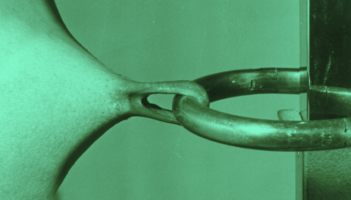 Nipple Loops, 1963 (Age 33). With tubes removed, Fakir's nipples became perfectly proportioned loops, here shown with a 3/8" thick brass pull ring inside. PLEASE NOTE: Fakir's nipples were NOT PIERCED in the aureoles, but precisely at their base as seen in this photo. This is why they healed well and were capable of extreme enlargement. At this point, nipple tissue had increased 1500%! |
FAKIR: They only were inspiration. You have to understand I have my own idea and definition of ritual, and also of pain. Those two are very important to me. Ritual is simply going into an act. It's like a play. You know what you start with, and you know what the desired result is. Like a Sundance: You know you're going to fast and prepare yourself, you're going to want to go to some other space. The beginning is the piercing, the end ripping the flesh free. What happens in-between is always different and always spontaneous. People are stuck in this rut with Western Judeo-culture, like going to a Catholic church where you have a mythol. And they think of that as ritual. The anthropologists went out and old Indians in South Dakota laughed. They asked, "This Pow-wow dance, do you put the red here, and the green here, and do move this way five steps?" and they'd give them all kinds of bullshit because they couldn't understand, when you do a ritual what you're trying to achieve is the ritual. How you get there is different every time. The people in Western culture are just stuck with that notion that you go from A to B, and so forth. Their idea of ritual is very different. So I'd say the other culture's influence on me has mainly been inspiration. I go for the same end result. I do not claim that I did a Native American Sundance. I did my version of a Sundance. I'm not ripping them off. We are inspired by the same thing and our goal was to zoom out into cosmic space or something.
BME: What would you say to people who say that borrowing ideas from cultures is offensive to those cultures?
FAKIR: That came up several times. Boston, on television, I had Native Americans say "You're ripping us off!" and I said, "No I'm not, I'm seeking inner experiences in the same kind of way some of your forebearers did. What do you do for ritual?" They said "We go to the Episcopal Church." I said, "Have you ever done a Sundance? Have you ever seen a Sundance?" "No, no." "Well go see one once. I grew up with people who do this and they know what I do and they say Bully." They understand that what we're trying to do is get the result.
BME: So then there's not really anything you need to do to be respectful?
FAKIR: I'm sorry if any of them feel offended. I've gone over and done this stuff with Savite Hindus. I have a very good friend who's Kumar who's a Kali priest in Panang and they know fully what I'm doing and they've seen me do things and I've been with them when they've done things and we're going for the same thing and we're going to the same places. Our rituals are designed to go the same path and get to the same spot. How you get there, all the little detail in between, isn't of any concern.
BME: You actually going there, and seeing it firsthand, is fairly recent?
FAKIR: Yes. I was inspired to do Kavadi first when I was only in my teens. I saw the glassy eyes -- One of my early gifts was psychometry and I've been able to do that particularly with photographs. Psychometry is touching something or someone and knowing all there is to know about them just by psychic contact. Like the rock on the Indian burial ground. That's always been and it's still there. I would look at these pictures and the captions, the text that went with them, was all bullshit. I finally realized that by psychometry. If I meditated on the Hindu man with the glassy eyes and the Kavadi frame and spears, I could get into the same state as he was in when this photograph was taken and know what he was feeling and why he was there. That's how I've been able to do most of my rituals by the way. I feel that what I am doing is a form of psychometry. By capturing the image I can go into that consciousness, I can go into that time, and into that mind or feeling world and come back with whatever is there. Sometimes it's frightening or scary, that's how I was inspired to do the O Kee Pa, the Mandan ritual, hanging by the chest piercing.
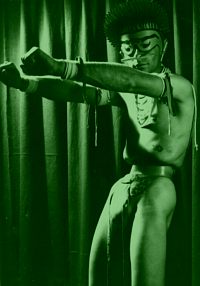 Ibitoe, 1956 (Age 26). Fakir has had a life-long desire to emulate the Ibitoe boys of New Guinea. Here he wears the tight "Itaburi" (belt) of the Ibitoe along with a pierced septum, ears, ligatures and Ibitoe headpiece. |
FAKIR: [The full story of this is printed in Body Play]
It far exceeded my expectations. The morning of the literal ceremony when people started with the piercings, I was in a nearby hotel in downtown Penang, a couple of blocks away. I was afraid to get up and go over there. Two things I feared: One, it would be weak, and the energy wouldn't be there and I would be disappointed after waiting fifty years to see it. Two, it would be so hot, I wouldn't be able to help myself, I would rip off my clothes and start pushing rods through my body. As it turned out, neither of those things happened. I was totally swallowed up in the energy, it is so magical. Body rites of the Savite Hindus are so powerful. A European wanders in there and they get heady, it's like having about two bottles of whiskey or something. They get totally intoxicated in that atmosphere. And these people are taking nothing. They're just doing their thing, they've got their ritual, they know where they're going to go with it, they've been trained since childhood to do these things, and it is strong!
FAKIR: No. You have to look. All these practices in recent times have been suppressed. So called "large mass piercing and torture rights" really belong in India among the Tamil people. These are the original people who lived in India, and 20,000 years ago build a high culture, and they gave us the written language Sanskrit, all the literature, they gave us all the Yogas, they gave us Tantric practices. All of that came from Savite India. Then the Vedics came and drove them out, pushed them down four or five times, in the south of India. These people have been treated as slaves through the colonial period. They hauled them off by the thousands to slave and pick tea in Sealan, and mine tin in Asia, etc. The British exploited them horribly. But they've always maintained their culture and their religious practices. They're very charming and graceful, but to get into the inner secrets, uh-uh. Very difficult. When we were there, in two trips, we penetrated and sat in the temple, in the tropical rain, with Kumar and his friends. One guy, his brother had the record of having the most hooks in his body -- He had 900 metal pots hooked in his body, walked seven miles, and then walked down a seventy foot ret-hot coals.
BME: Are they happy to see a Westerner interested?
FAKIR: They're very gracious. They were sort of blown away by what we were doing and very surprised to find other people doing this kind of thing. Just like earlier, years ago, I found some Native Americans who were this way because I was doing Sundances before they reinstituted the custom. Now they're doing it in spades, but some of them are not getting it and doing it the way they did it traditionally. And I am. Some of the young guys get pierced, and they dance for a little bit, and then they go back with one mighty leap and try to break free to get it over with. The object of this is not to try and break free, but to pull on the Goddamn piercing for hours and days if possible and go into a trance. If you rip free right away you obliterate the chance of something good happening.
BME: Piercers who see their work as a technical act would probably take almost offence at these statements.
FAKIR: Well, my experience goes back to the early days at Gauntlet and working with people there and I knew something was wrong. Some of the piercers would take people into the little booth and pull the purple curtain and we would year the Godaweful scream "ehhhhh!". And I said that isn't what's supposed to happen when you pierce people. There was something wrong. Well, it turns out that technical skill is one thing... I have one protege that's now working very hard to develop the shamanic side of it. In fact, we put a great deal of emphasis in our five days and my piercing school on the shamanic side of doing body piercing because it's just as important as health and safety. And this is where people get the real service when they get pierced. They usually have something they want to happen to them, conscious or unconscious. It's not going to happen if the piercer isn't aware of this and isn't capable and trained enough in magick to make it happen. To us it's an art, it's a skill, it has it's health and safety and medical aspects which you damn well better be aware of, but one of the more important things that happens when you do a body piercing... it isn't just putting steel through flesh, you're doing an act of psychic penetration here, you're opening openings in the body and things can go in and come out of those openings. So you damn well better know what you're doing magically or you could do a disservice to the people you pierce. So we try the best we can to get people introduced to that in the Fakir Intensives.
FAKIR: I'm asked that one a lot. My own three years of private exploration used absolutely nothing. I can get just high and get to other dimensions, and shift consciousness beautifully without it. Not everybody can. You have to realize that what I'm on is the body approach to opening up and accessing inner stuff, inner space. When you're taking a psychedelic or any psychoactive, you're doing the same thing, you're doing it just a slightly different way. What you're doing is taking a plant substance that is changing something in your body physically. I've had a lot of experience recently with Santo Dime. The Brazilians have an ancient church and they make use of a substance called Ayuhuasca.
BME: It's a tryptomine?
FAKIR: Chemically the essential ingredient is dimethyl tryptomine (DMT). When they get with their Ayuhuasca in their ritual, that's brewed in the jungle, is very different from what you get with chemically prepared stuff. Some people say the same thing about using real good mushrooms versus using artifically created material. The plant spirits don't really work well through the chemically made stuff. So yes, there is a place for this in all ritual, in all spiritual and religious exploration. There's definitely a place for plant substances. But we're doing the same thing as hanging the body up by flesh hooks. We are intervening in the body to create some special kind of consciousness.
BME: What relationship do you see between ancient rituals and modern rave rituals? Both are endurance-based, trance-inducing ordeals...
FAKIR: Ok, raves are an ecstatic rite. People go there to seek ecstasy. They go there to combine spirit, body, and get that feeling of escape and unity when you're not all tied up in one world or the other. That's not much different from what they do in Africa or what they do in the South Pacific. And they sometimes use plant substances too. It's a rediscovery of something that's always been here. The body piercing movement and everything these people are into is nothing new. That's one thing I always emphasize. It's just a rediscovery of something that's already been there. Fakir isn't bringing anything new. Fakir is just by example reintroducing something that's always been there. People have always been able to access this. The only reason they haven't is because of the prohibitions, the programming or Western Judeo-culture.
FAKIR: [The full definition is printed in Body Play #1]
There's no word in our culture for this so I invented that word to cover it. It's using the body and playing with it.
BME: Originally you were with PFIQ. What made you move from PFIQ to Body Play?
FAKIR: The limitations of PFIQ. It very exclusively covers just contemporary body piercing and pictures, and doesn't have a whole lot of meat in it. I saw what was happening in body piercing as a part of a million other things that I'd practiced for 34 years and nobody was addressing it.
BME: So the point wasn't body piercing, the point was what was behind it?
FAKIR: Yes. I was more interested in why people are doing it and what they get out of it than I am in the actual literal doing of it or the seeing of it. For 10 or 15 years I was a major contributor and later an editor and my goal was to make PFIQ a little broader and a little more inclusive. The thing that I felt was lacking was real life stories by real life people with pictures to go with it. That was my goal. I wanted substance, I wanted content, I wanted education. I wanted some solid stuff here to bite on, and the prevailing attitude of the people at Gauntlet was they didn't want that...
BME: Why not?
FAKIR: I don't know. Since then they've tried to change the format and they've copied and aped me for about three years now. Every time I do something... I do something on Vadra Vamra, they put him on the cover a year later. I do something on flesh hooks, they're looking all over to find people for flesh hooks.
BME: I guess there's 'In the Flesh' doing that as well now.
FAKIR: There's enough stuff and enough people out there, I mean, god, be original! Why don't they just go out and get something new! No problem! [laughs]
BME: So basically you were filling a void that PFIQ or any tattoo magazine couldn't fill.
FAKIR: Yeah, or any religious, spiritual, or new age magazine too, because I'm addressing all of that... They don't know where to put Body Play sometimes. I've gotten on the New Age counter in some bookstores like Barnes & Noble. They don't know where to put me. Some places I get in with the sex magazines. Sometimes I get in with the piercing, tattooing, and biker magazines. There isn't really a place for Body Play.
FAKIR: In my case I go out into a lot of different communities, I have a lot of traffic with a lot of people. For instance I look around for a friendly doctor in an SM group. If we want advice on what to do if someone passes out from being whipped too hard, we have our friendly doctor in the SM group who's into whipping. I have another patron millionaire who has many, many connections. Many highly placed people, and always when I need specialized information I usually go and ask him to find someone for me and he usually does. I want a doctor, or a plastic surgeon... it pays to be a millionaire -- you get a lot of access that way. And if you can't be a millionaire, it pays to have one or two that are friendly with you, because they can usually do stuff that you can't normally do.
FAKIR: It leaves me shaking cold because it's not being done for any purpose that's ritual or expanding consciousness.
BME: Does there need to be a balance between spirit and aesthetic, or can they be unrelated issues?
FAKIR: My feeling is there should always be a connection between inner life and the practices we do in outer life. Not to have a connection, or to avoid having a connection is to seek imbalance, and when you have imbalance you get Darth Vader!
BME: You spent a long time on the cutting edge of the industry... What advice would you have for these people currently on that edge?
FAKIR: I would caution them to be aware of the fact that they're doing magic, not just aesthetics and show business. And not to get carried away with ego because the psychic consequences are very serious. The penalties are very stiff for abuse and misuse of this kind of power. When you carried away with flights of fancy on implants, and I can do bigger than you, and I can... There we're getting off on ego trips and you're doing ego tripping on something that's essentially shamanic and Magick. The law isn't going to come and bust you but the psychic law is always patrolling. You're going to get caught sooner or later and have to pay a penalty for misuse.
BME: Who or what patrols that...?
FAKIR: Well, again, I guess I've got to use an analogy. Because I just saw the last of the Star Wars trilogy it's very much like Lucas presented, it's very much like The Force. All these things, whether you're using plant substances to journey, or whether you're hanging in cottonwood trees with flesh hooks, all of these things are best done with the aid and approval of the "force". Not to do it that was is opening yourself up to incredible risks and disappointments and problems and despair and possibly even death.
BME: Do you wish you were less famous?
FAKIR: Sometimes.
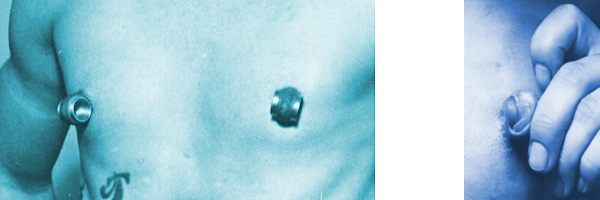 3/4" Nipple Tubes, 1962 (Age 32). After several years of patient enlargement, mostly with tubes that got increasing layers of wrapping in the style of Borneo subangs, Fakir wore three-quarter inch tubes in his nipples night and day. Nipples loops were so large they could be turned inside-out. |
FAKIR: Yup.
BME: And then...
FAKIR: This was long term, slow masochism. It was adjusting, it was changing the body slowly. I grooved on the sensation of cutting myself in half with the belt, and it would get so tight, and it would get very difficult and I would get very charged by it and it would become erotic and I wanted even tighter. The belt works fine, and it's great to train the body, but in the long haul you've got to train more of the torso than a two or three inch wide strip in the middle. I realized that you needed corsets.
I had such a passion to do this, and I had training, I have a masters in technical theater and I had gotten a lot of training in costume design and whatnot, I was skilled at making costumes. So I said, "what the hell, I can't find or buy corsets, and any corsets they made won't fit". Nobody had made a new pattern for ninety years so I went into my basic training I had in costume design and figured out how to make corset patterns which have to be made off sculpted mannequins. So I made the first patterns mainly to make coresets for myself. I had already trained and become an inveterate lacer in a corset made by somebody else, a leather one from Mexico. But it was not adequate and it wouldn't do the job quite right. So I learned how to make corsets and I made them first for myself and then for other people. It's a wonderful, marvelous thing, and I've continued on with corseting ever since then and I'm corseting right now, and back in training, and going back down to 19".
BME: Since you can probably claim some credit for this, why do you think corsetry is back in style?
FAKIR: Corset mania runs in hundred year cycles. Every hundred years there's a corset cycle and it's happened for 400 years in a row now, and there's no reason for it to stop. The last corset mania reached it's peak about 1890. The one before that was 1790. I traced all of this. And you reach extremes in corseting, this extreme in fashion, at the end of each century. So we are now very close to the end of the century -- There's got to be corset mania, just like 2090 there'll also be another corset mania regardless. Now the corsets are different... They may be made out of rubber, plastic, and PVC, they may be worn on the outsides of the garments instead of the insides, and god knows what they'll be made of in 2090, but you can bet that 2090 there'll be another corset cycle.
FAKIR: Well, I don't know... brief?
BME: Well, you went to highschool, you went to university for technical theater...
FAKIR: No, I first went to Northern State College and I have a Bachelors degree in Science and Education and I taught high school for a year, and English, speech, drama, journalism. And then I came to California and I got a Masters degree from San Francisco State University in Technical Theater and Creative Writing. I had a job in theater. I was actually the tech director for the actor's workshop for a couple of years; lighting and scenic design, etc. They moved to New York. Also I had a job at SF State teaching tech theater, scenic design, make-up and costume. Not being able to find ultimate good employment there I finally wandered off and had a series of odd things... I was an engraver for high tech industries, I taught dancing (that's where I got into corsets), because of the creative writing and tech background (when I started out to be an electrical engineer), I got a job as a copy writer at Ampex corporation and that started a 27 year career in high tech advertising. I worked in large SF agencies being an account supervisor for United Technologies, Memorex, and people like that. Then I worked in a number of agencies over on the peninsula and in Silicon Valley and finally had my own agency for 17 years.
 The Collar, 1962 (Age 32). Fakir's bodymod is quite total; Here a 6" collar lengthens his neck, a steel rod is used to stretch nipples and his waist is compressed by a tight belt. |
FAKIR: Yes, that's covered in Body Play #1.
I did a branding ritual in Torrence, CA, last week. It was quite successful. It went till three in the morning. I did about seven people. The last one was about a 17 strike brand and on strike eight the lights went out. People were very helpful. We had rhythm, we had chanting, we had incense, we had drums, and they brought in flashlights, and we finished it with flashlights.
BME: When you first started offering branding to others, it was in your immediate group?
FAKIR: Yup. It was just sharing because people wanted the experience.
BME: When did the seminars start?
FAKIR: It was like the body piercing, but much later, and much smaller. It's still fairly small, but now I'm finding regular people four times a year to attend a class, I have a school in it. The aesthetic, the feeling, and the magic of branding is so different than tattooing. There are a certain number of people who don't really like tattooing but they like branding, particularly the experience of multi-strike branding that might take an hour or so of repeated burning in a very rhythmic fashion. It adapts itself very well to ritual and to transformative experiences. More so than tattooing, and it isn't instant and hot like body piercing. That's a real different experience too. It has it's place ritually. Branding has a different space.
There were a lot of people who were starting to dabble and they were using soldering irons, and hot wires, and the biggest problem I had was in the SM community. There were some people representing themselves as "brand masters" and they made mini-versions of what were cattle brands. Which don't work at all on people! And I saw some of my friends in the SM community getting horribly mutilated. They didn't realize that the width of the red hot metal, when it heals it will be three times wider than that. So all of the brands came out to be big nasty holes or blobs. And I had to have the experience back in my early days, ten thousandths of an inch giving me a very wide line. They didn't know what they were doing. So that how I got started teaching some branding. So that people would avoid that trouble.
FAKIR: The only people I deal with and surround myself with are people from 17 to 27. Very seldom do I even have any traffic with anyone older than thirty. And so I just kind of think I'm 27 years old. But I'm not 27. I'm actually going to be 67 years old. I decided two years ago that I'm going to get younger instead of older, and it seems to be working. I can be kind of a gender bender at times; I cross dress sometimes, I go out into public. I can wear the highest of high heels and have the smallest of waists going down the streets.
BME: You have a lot of fun.
FAKIR: I do. I enjoy life.
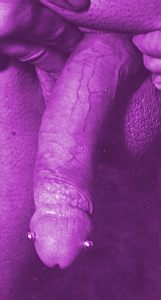 Ampallang, 1978 (Age 48). No one in Western Culture had the exotic Borneo Ampallang piercing in 1978. But Fakir was so eager to have it, he invented a technique and pierced himself late one night. Since then he has installed hundreds of Ampallangs and taught many others how to make them safely and correctly placed. |
FAKIR: We invented all of that. I'm talking about Jim Ward, myself, and about five other people. We invented the whole thing. There were no needles, there was no jewelry, there were no techniques, they didn't even know what kinds of things you could pierce that would work. All of that was developed between 1969 and 1975. And it was all developed out of this core group that was held together and brought together by Doug Malloy.
BME: Everybody knows what happened to you, and everybody knows what happened to Jim, but what happened to the others?
FAKIR: There was Sailor Sid. Sailor Sid is dead. There was Alan Oversby who I had dinner with last November. He's gone (Mr. Sebastian). There's Sammy Horsefrekenback. I don't know where Sammy is. He's in Germany. There were three of four people where I can't mention their names because they don't want to be known. There were some piercing pioneers that no one will ever hear of, like the couple in Texas who had a pierced nipple when there were only seven people in the whole Western world with pierced nipples.
BME: That you knew of.
FAKIR: That was about 1976.
BME: Didn't Europe have a flourishing heterosexual piercing scene at that point?
FAKIR: No. The only people that had piercings in Europe at that time were circus freaks that worked in a German carnival. I know a couple of people of people who had pierced nipples and tongues and they only had it so they could put a hook in it and pull a wagon across a stage and make a living. Only ones... The phenomena started as far as I know, and I've been here the whole while, in Los Angeles, in West Hollywood. And the first place it was open, was a little store on Santa Monica Boulevard that we all thought would not go (we couldn't make $750 rent on the place). I used to fly down every weekend and pierce when it first got started. It got that there were more people than piercers and it was all gay males. The most popular piercings were Prince Alberts and nipples. It grew and grew and grew from the gay people, there were gay SM people, who in turn used to play with straight SM people, so then the next group who came through were the straight SM people. And the guys and their slave women (general) were getting labias, etc. pierced. That was the next wave. There was an era for each of these. The later wave got to be the punks. From that it went out into the general youth population.
BME: Did any of the circus folks, for example Rasmus Neilson (a circus performer with a huge Madison and nipple piercings), cross over into your group?
FAKIR: No. They had a different world all their own. I'm sure Rasmus Neilson thought there would never be anybody else who would pierce their nipples and put hooks in them.
BME: Doug Malloy made his money from MUZAK?
FAKIR: Amongst other things. He was a self-made millionaire who came from a dirt-poor family up in Washington. He had a little man who came and guided him psychically and that's how he became a millionaire by age 24. He had the golden touch. He was a spiritual man, he was a psychic man. We hit it off beautifully. In the final days he had a bit of difficulty with Jim because Jim wasn't going down the spiritual path and he died unexpectedly on us so that it never got totally resolved.
BME: Doug seems to have been a bit more private than the rest of you, but was he as actively interested in it as the rest of your core group?
FAKIR: More so. He was totally into it. Doug Malloy was a bisexual man, who haunted all the odd little neighborhoods and little goings-on, particularly in Los Angeles, but because he had money he was able to go all over the world, and check this out in New York, and SF, and London, and make friends. He just had an absolute passion that this should come alive and be more available to people who really wanted body piercings. He was also into tattooing and a lot of other kinky things. He lived across the street from Bob Hope in Tuluca Lake [laughs]. And right behind him was Nancy Sinatra. A real celebrity filled world with gates and guards and stuff and he used to come out to Hollywood and pick us up in a classic Silver Cloud Rolls Royce, and you could park in the middle of the street and every one would drive around you and wonder what movie star this was. Ha! It was very nice.
BME: I guess you guys had no idea that piercing would become the huge commercial industry that it is now.
FAKIR: Definitely not.
BME: Do you think it will continue to be that? How much is fad?
FAKIR: I think it's in our culture now and it's going to stay, but I think that a lot of it has gone over the peak. We can tell by the proliferation. I've trained more than the majority of the people out there trying to make a living at it. Very hard to make a living doing this. There are only a few people doing this that actually make any money at it. It's done mostly for passion and mostly for joy and mostly for fun. I keep training these people ten at a time and I get very intimately connected with them. I know who they are and I follow them up for two or three years. But still, people want this. It was a needed service that was not provided in our culture. So I look upon it as being cultural aid, cultural support, to have trained body piercers, particularly the ones who know the art, the skill, and the magic. Because mostly what the people come in for nowadays is the magic. We're finding this more and more. People come to us and say, "Can you teach us to do this more shamanically? I want the flesh to part and the needle to go through and go into ecstatic states." I have a lot of people come to me and about half of them come to me for mainly that reason. And we do teach them the most sophisticated techniques and skills. I've got a network of a hundred people who are constantly connecting with each other and passing information this way and that, and doing this every day. And that's what we put into our school. It's the cumulative knowledge and ongoing learning experience of hundreds of people on an ongoing basis. That's what makes what we're doing so good.
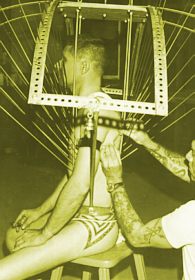 Taking Kavadi, 1963 (Age 33). Pierced by 100 metal rods in his chest and back, Fakir dances to ecstasy during his first attempt to experience this Savite Hindu body rite. Piercer is tattoo artist Davy Jones (see Body Play #5 for the whole story) |
FAKIR: Eric was a groupie, piercing novice/devote in Santa Cruz. We had these odd calls come in, most of which were hung up on. Somebody would say, "This is so-and-so in Berkeley and we're having this festival and we were wondering if you could send a body piercer over here because some people would like to get body piercings?" And the general attitude was "Why bother. If they want a piercing, have them come over and see us on Market Street." I happened to pick up one of these calls one day and it was somebody in Santa Cruz in an art gallery having a ritual that wanted to include some piercing. They asked if Gauntlet could send somebody over, and I said, "No, but I'm Fakir and I'd be happy to come down there". So I did. So I started doing a few of these little gigs, and in the course of these I'd usually do a little slide-talk about what's piercing and what's available and how they're done and what kinds of piercings you can get and a little background and about the magic of it a little bit. And then we'd have a little piercing ritual in closed quarters where we'd take our clothes off and pound drums and the whole number. It was at these that I met Eric and a whole mess of others. Allen Faulkner and all these other people.
FAKIR: Actually I met her but didn't know her at an SM group four years before, Janus Society in San Francisco, and she was this weird French woman who kept binding her breasts with rope, and making fun play out of it. And I though, "Hmm... That's intriguing," because I've always been into that sort of thing. Then when we premiered, the world theatrical premiere of the Dances film, the film makers thought it was only appropriate to do it in SF. They had trouble finding a good theater to do it in, so we finally ended up in the Mission District, at the Roxy, which is an avant-guard, experimental kind of place where they show those kind of movies. We did the world premiere and that was very successful. Sell-out for a week, two shows a day, or something like that. I talked at most of them. She lived nearby, and she hung around, and she volunteered to get us a place to hold an opening party, and I could use her apartment to dress in and rest in and so on, so we made a date to have a date on a fourth of July (it was like ten years ago), and we got stuck with each other. We're both very open, we're both experimental, we're both into SM, we're both bisexual...
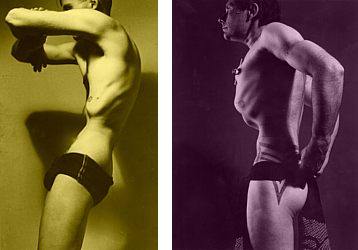 Young&Mature Ibitoe, 1952&82 (Ages 22&82). These two photos show the dramatic result of 30 years of patient body modification. Fakir's persistent wearing of tight belts has radically altered his torso. His chest had expanded ten inches but his waist and hips have remained the exact same dimension all these years. Especially notice the resculpting and placement of the rib cage. Radical! |
FAKIR: We've got a very strong spiritual relationship and we go out and do the things we did the weekend, in Los Angeles, the branding and so on. We work together as a team, and work with a group of people, sometimes very derisive, uncooperative people, and usually make it come off where they feel it emotionally and get strong and get involved and something really nice happens.
BME: And body play and art and ritual has been a strong part of that.
FAKIR: Oh yes. The Dances thing showed at around a number of theaters. First it did a year on the festival circuit, got very nice reviews in London, Italy, etc. I went over to Europe, that time with Annie Sprinkle actually and went to a couple of those and spoke at them, like at Antwerp and places like that. Then it came back over here and they premiered it at the Roxy, and showed at various places around the United States and I went to those and always took Cleo with me and she would sell T-shirts and just generally help out.
BME: Do you think that all the other aspects that you two have gives your relationship a strength that other people don't have?
FAKIR: Yeah. We can share. We can share very much in this spiritual realm, and since we're both coming from the standpoint of body art oriented expression and ritual, it works fine. We work together with our people very nicely doing suspensions, piercings, endless piercing rituals, the Savite Hindu rites that we do every summer, and on and off during the year. We've done balldances for Fear Against AIDS for a number of years in a row, the red dog moon or whatever. These kinds of rituals and piercing rituals can be very helpful to heal community. All of the reasons that I give in the magic of piercing, in I think the second issue of BP.
BME: What's coming up for you?
FAKIR: I see more shamanic work. This year I see a little bit of travel. I have to be very selective because I get endless invites. I must get five college students doing papers on modern primitives a week (which I can't handle). We had all these invites to European festivals and things because of the name. Every now and then one comes up that's appealing. I'd like to get a bit more private time. Every day I spend at least half an hour doing my body play and my shamanic work. Doing writing. I have a friend who's published four or five books who has a couple of major publishers interested in doing my autobiography, which I would never have dreamed of doing a year or two ago, but I've had five years of psychotherapy and I've gone through all these experiences and I feel that maybe now I can be honest enough to do it.
BME: Do you mean traditional psychotherapy?
FAKIR: Yes, traditional western psychotherapy.
BME: How does that go together...?
FAKIR: With what I'm doing? Well, I got into a terrible state back when I had my fallout with Jim in that grim period five year ago, and that's how I originally happened to go. Sort of like, "I'm kind of fallen apart, can you help me?" [laughs]. And since then it's become wonderful. Now you have to understand that I'm with a very well accredited, mainstream, but gay, Jewish, Jungian therapist. Which makes all the difference in the world. Who feels that he is doing shamanic work. So he is a shaman in his specialty, working with me, a shaman in other specialties. It's help me work out a lot of stuff. I feel that to really write a book that's worthwhile, and I only have one book in me, it's got to be totally honest, and I've got to say and fess up to stuff that I would even tell myself. I'm not going to do it until I feel I can do that, and I think I'm about ready. I need to take a year off to do the mechanical part of it. The story's been told a thousand times, the hidden corners have never been touched. I do need someone who will take a couple of chapters and an outline, and give me a $25,000 advance so I can afford to do it, but that's not a problem.
BME: More speculatively, what do you see coming up for the industry / community?
FAKIR: I talked to Ron Athey and Annie Sprinkle recently and we were pioneers in body stuff, she in showing off and doing the sexual side of it, and he in doing really grim rites with play needles and stuff, bloody rites and tattoo. Ron was thinking, this year's freaks are downing last year's freaks as old hat, is what he's been running into. He's been doing the Europe circuit, and what he did before was really hard to get and really not something you ought to take into public. Now it is. Ron has matured; he's doing stuff that is really deep -- has meaning, and form. He's really got an art going here. But of course, there are this year's freaks, that are bloodier than last year's freaks, and he was considered the bloodiest of freaks and so now he's a has been. Annie Sprinkle is too. We were talking, "Are we all has beens or what?" It's just a phase. In the long haul, I'm going to be remembered, I'm sure, and it's not really me... You've got to understand, I look at myself, I'm just an archetype -- These people are tuning. What these people are tuning into when they see Fakir and the Modern Primitives book and they see all this other stuff coming along, they're tuning into an archetypal person, an archetype that's universal. And I can't take it personal when they come up and say, "you transformed my life". I didn't transform their life. I was just a channel and there was this archetype that calls himself Fakir that did something, that caused them to go off and try something new. That's really where I'm coming from.
BME: If you could some up what you want to accomplish in your life...
FAKIR: Well I think I've pretty much accomplished it. I'm just sitting back now. This is Apul Gira on the ruins. This is the time of harvest when you get to see how the stuff turns out after you planted it. So I'm in a period where I'm watching stuff grow and admiring and watching the beauty of the flowers. No kidding. And I'm very optimistic about where it all is going. What I feel has happened is people have opened up to the kind of experience that would result in transformation and there's one lady who writes extensively on this stuff Atwater, Beyond the Light, who studied near-death, because what we're doing is very similar to the people exploring the near-death experience. She sees what's happening to people having near-death, very common, regardless of their experience, she doesn't care what they saw, where they went... What are they like a month later, a year later is important. She sees a brain shift. They behave and function differently. They understand in a different way. I've had the same experience with people who've hade a lot of the Dime, the Ayuhuasca experience tends to do the same thing. It's a body approach too. When we get enough brain shifted people we can have a new culture. Ted Polemous over in London speculates a lot about where we're going, where do we go after the fetish of the fetish... I didn't like him for a while and I got stuck at Heathrow airport with him for five hours and we really had a chance to get acquainted and boy, we tuned in. And then we got on a panel in Copenhagen, and we had a two hour debate on where culture is going. What do you do when everybody's so individuated that society falls apart? He was very concerned about that. Because society was originally made on the primitive model which is arms, legs, fingers, eyes; a body. What happens after we have done enough body play and body experimenting and everything gets fragmented and everybody is totally individualistic and we have no more society, we have nothing in common with each other. He couldn't possibly conceive of, when you go through that experience, a lot of people are going to get brain shifted, and behave differently, and see, and understand things differently. They can come together and make a new society, on a new model. That was my suggestion, that's where I think it's headed.
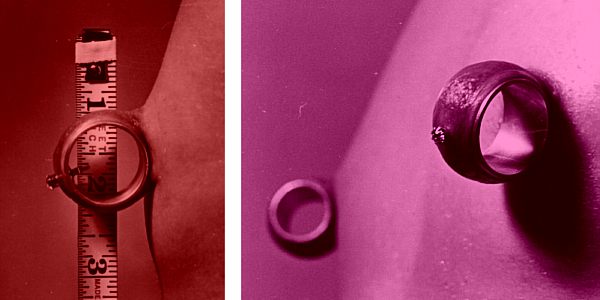 One-Inch Nipples, 1973 (Age 43). It took ten more years for Fakir to reach his ultimate goal: one-inch nipples, shown in these photos next to a tape measure to verify honesty. An additional piercing was made in the tips for studs that kept the nipple tubes in place. |
 Enlargement History, 1973 This photo was taken in 1973 to show the various nipple ornamentation worn during Fakir's long enlargement process. At extreme left, original four strands of thread. At extreme right, the one-inch tube. |
FAKIR: Ultimately we all go the same way. I like to think that maybe I'm prepared, but then again, you never know. No matter who you are or where you are... Ram Dass had a stroke and he was paralyzed and couldn't speak. That's the last thing in the world we expected to happen for Ram Dass. I'm sure Ram Dass never expected it either! You know, he's Baba, he sat in a cave, he had thousands of people worshiping him for a while. Didn't expect him to go to his Merton County apartment with his lover and have a heart attack but that's what happened. So you take it as it comes. You never know what's going to be the next thing you're going to do. For me, personally, it's learning to live with the unexpected, because in the last year it particularly accelerated for me, and the unexpected happens on a daily basis. Learning to live with it is learning to live shamanically. For me, I'm getting into a period of fulfilling my shamanic dream, being able to function the way I really probably should function, and of course, ultimately, I'm going to leave this coil. I meditate on that every day, about the impermanence of everything, including me! Especially me.
BME: To people who don't understand a lot of what you're saying, and who see it as some kind of craziness, what are the key things they need to change in their way of thinking to understand where you're coming from?
FAKIR: Well, I think that things have been changed, but only in younger people. There are older people who will never understand. They're just going to have to live their life and die and go wherever they go. But I have a lot of hope for a lot of people whose eyes have been opened. This is a period of great openness. I have a great optimism here for a lot of people wanting, going for, taking risks, and getting involved in physical life to the point where they have transformative experiences.
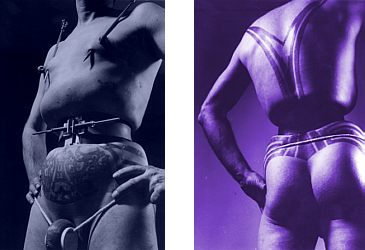 The Complete Ibitoe, 1977 (Age 47). Fakir's idea of the complete "modern primitive dandy" includes: deep chest piercings, tubes in nipples, symbolic blackwork tattooing, lengthened penis wrapped around a large tube AND a small belted waist here being compressed by a screw-on locking belt only 20 inches around it's inside! NOTE: Blackwork tattooing seen on tummy and back was unknown in 1962 when Fakir began his. Fakir had to search five years to find a tattoo artist who would put this design on his body. |
BME: So it's just a matter of finding a backer that'll give you an advance?
FAKIR: Well, to hell with someone! Hey, if I can change the shape and size of my body, and I've done some remarkable, marvelous physical changing, in myself and others, and I said, "gee, why can't I do that in my world?" and I started doing that one. It works great. I'm unlimited spirit flowing into my body. I'm my unlimited body putting unlimited amounts of money into my bank account... The next day I had $3000.
BME: Well where did it come from?
FAKIR: Unexpectedly! No, no... If you can manipulate anything in the physical world by these things, anything at all, you can manipulate all the rest of it. This is where I'm at in my practice right now, and it started with my body piercing and so forth. I've bent my feet, I've changed the shape of my body, I've made my waist go up and down, I've grown big nipple and little tits, and I've done all kinds of weird things. I've stretched my neck, I've sculpted my arms, and from that I learned something.
BME: It's more than just changing your body, it inundates every aspect of your life.
FAKIR: Yeah, what's behind it? Why does it work, and what do you learn, and what relation do you get between body and spirit? I've got that one worked out really well. I've got another book on that subject which I may get published.
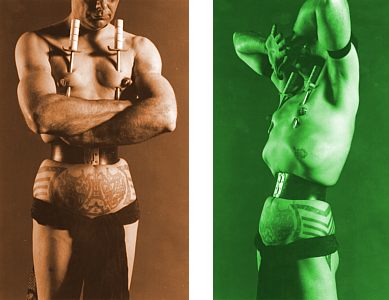 Bodymod Pioneer Fakir as he appears in the 1990's. |